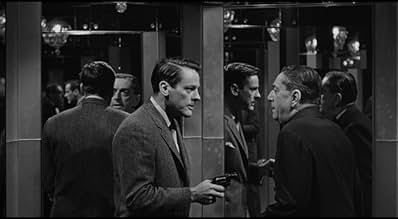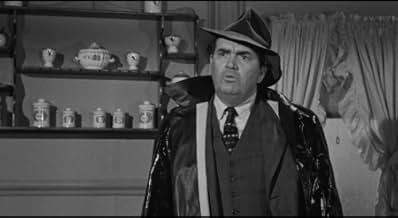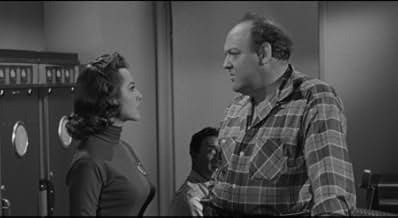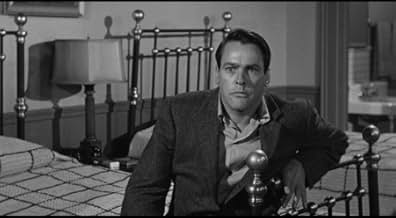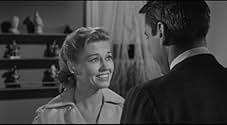AVALIAÇÃO DA IMDb
6,4/10
1,4 mil
SUA AVALIAÇÃO
Um músico de Nova Orleans tem um pesadelo em que mata um homem em uma casa estranha, mas ele suspeita que isso realmente aconteceu.Um músico de Nova Orleans tem um pesadelo em que mata um homem em uma casa estranha, mas ele suspeita que isso realmente aconteceu.Um músico de Nova Orleans tem um pesadelo em que mata um homem em uma casa estranha, mas ele suspeita que isso realmente aconteceu.
- Direção
- Roteiristas
- Artistas
Ralph Brooks
- Oscar - the Bartender
- (não creditado)
Jack Chefe
- Nightclub Waiter
- (não creditado)
John Mitchum
- Onlooker at Stan's Suicide Attempt
- (não creditado)
Cosmo Sardo
- Nightclub Patron
- (não creditado)
- Direção
- Roteiristas
- Elenco e equipe completos
- Produção, bilheteria e muito mais no IMDbPro
Avaliações em destaque
If you can get past the improbable key to the mystery, the rest of the movie has some good, strong points. The first twenty minutes plunge us into McCarthy's nightmarish events that may or may not have actually happened. We don't know for sure and neither does he, but there are the scratches on his arm. Did he kill those people or not. The surreal effects are impressively done.
McCarthy delivers a gripping performance, as good as Invasion of the Body Snatchers (also 1956), and much better than expected for a B-movie. In short, he makes us believe that his dilemma, however improbable, is real and not just a story construct. Without that intensity drawing us in, the movie would, I think, amount to little more than a mildly interesting walk-through.
The New Orleans locations provide a clever anchor to the real world, and a good setting for the colorful jazz scenes. However, a 63-year old Robinson is at least 10 years too old for the brother-in-law part even though he manages the cop role well. And can we really believe the chance occurrence onto the scene-of-the-crime mansion in all that unfamiliar backcountry. Unfortunately, the script requires more than just an ordinary suspension of disbelief. Too bad the script couldn't work in more bayou scenes. Those coming at the end are really creepy and nightmarish in their own right. Too bad also that the excellent McCarthy made so few films, preferring, I gather, stage productions instead. All in all, an interesting if regrettably flawed little movie.
McCarthy delivers a gripping performance, as good as Invasion of the Body Snatchers (also 1956), and much better than expected for a B-movie. In short, he makes us believe that his dilemma, however improbable, is real and not just a story construct. Without that intensity drawing us in, the movie would, I think, amount to little more than a mildly interesting walk-through.
The New Orleans locations provide a clever anchor to the real world, and a good setting for the colorful jazz scenes. However, a 63-year old Robinson is at least 10 years too old for the brother-in-law part even though he manages the cop role well. And can we really believe the chance occurrence onto the scene-of-the-crime mansion in all that unfamiliar backcountry. Unfortunately, the script requires more than just an ordinary suspension of disbelief. Too bad the script couldn't work in more bayou scenes. Those coming at the end are really creepy and nightmarish in their own right. Too bad also that the excellent McCarthy made so few films, preferring, I gather, stage productions instead. All in all, an interesting if regrettably flawed little movie.
This One has an Interesting Pedigree.
It is a Remake of a Film-Noir, Fear in the Night (1946) from the same Director, the Prolific (mostly screenplays) Maxwell Shane. Everybody Endlessly compares the two Movies,
This is a Distinctive Noir, at the End of the Cycle and it is Remarkable because it includes almost every Film-Noir Trope starting with the Title. Obsessive Fans of the Genre could make a List.
The least Impressive thing about "Nightmare" is the Print. TCM, a stickler for finding the Best Available, showed a very Unimpressive Version that was Weak all around. The Contrast is "Grayish" and the Look is very Flat. That Visual Disappointment Aside, the Film reminds of the Great Style that was all but Forgotten by 1956.
Seemingly Filmed on a Very Low Budget, it still manages to Conjure Up the Atmosphere of True Film-Noir. The On-Location Footage on the Streets and Bayou are "Nightmarish". The Film feels Odd and Off-Beat adding to the Enjoyment.
The Cast lead by Edward G. Robinson and Kevin Mccarthy give the Movie Gravitas and the Story, by Cornell Woolrich, is Rich with Mysterious Happenings and Dreamlike Displays.
If every Reviewer on Earth hasn't Spoiled the Ending You will Undoubtedly have a Fun Time with this Mystery Movie.
Highly Recommended for Low-Budget Entertainment.
This 1956 Film-Noir shows just what Staying Power the Genre could Generate. The Conservative Fifties, with Very Few Exceptions, had Hollywood Capitulating to Government Gawking and Back-Room Intimidation and the Cynical and Edgy Film-Noir Genre was Relegated to Cheap Second Features and within a Year or two was Abandoned Altogether.
Making a Comeback about Later, as Neo-Noir, the Movies Started Experimenting with a Renewed Energy as things were Opening Up Culturally and the Art Form found that the Freedom to Express was again winning the Public's Imagination and Imagination is obviously one of the Ingredients in the Creative Process.
It is a Remake of a Film-Noir, Fear in the Night (1946) from the same Director, the Prolific (mostly screenplays) Maxwell Shane. Everybody Endlessly compares the two Movies,
This is a Distinctive Noir, at the End of the Cycle and it is Remarkable because it includes almost every Film-Noir Trope starting with the Title. Obsessive Fans of the Genre could make a List.
The least Impressive thing about "Nightmare" is the Print. TCM, a stickler for finding the Best Available, showed a very Unimpressive Version that was Weak all around. The Contrast is "Grayish" and the Look is very Flat. That Visual Disappointment Aside, the Film reminds of the Great Style that was all but Forgotten by 1956.
Seemingly Filmed on a Very Low Budget, it still manages to Conjure Up the Atmosphere of True Film-Noir. The On-Location Footage on the Streets and Bayou are "Nightmarish". The Film feels Odd and Off-Beat adding to the Enjoyment.
The Cast lead by Edward G. Robinson and Kevin Mccarthy give the Movie Gravitas and the Story, by Cornell Woolrich, is Rich with Mysterious Happenings and Dreamlike Displays.
If every Reviewer on Earth hasn't Spoiled the Ending You will Undoubtedly have a Fun Time with this Mystery Movie.
Highly Recommended for Low-Budget Entertainment.
This 1956 Film-Noir shows just what Staying Power the Genre could Generate. The Conservative Fifties, with Very Few Exceptions, had Hollywood Capitulating to Government Gawking and Back-Room Intimidation and the Cynical and Edgy Film-Noir Genre was Relegated to Cheap Second Features and within a Year or two was Abandoned Altogether.
Making a Comeback about Later, as Neo-Noir, the Movies Started Experimenting with a Renewed Energy as things were Opening Up Culturally and the Art Form found that the Freedom to Express was again winning the Public's Imagination and Imagination is obviously one of the Ingredients in the Creative Process.
******SPOILERS****** Unbelievably heavy handed movie that telegraphs it's story to the audience so directly that you think it's a commercial for Western Union. Musician Stan Grayson, Kevin McCarthy, walks around most of the time in a zombie-like induced state and when he's conscious with his eyes bulging out of his head and looking like he's going into cardiac arrest at any moment that you want to run to the nearest phone and call 911 for help.
Waking up one morning at his room at the Hotel New Orleans from a nightmare that he had about him being a hall of mirrors and getting into a fight where he kills someone in self-defense Stan then opens a door and falls into a dark and bottomless pit. Stan looks in the mirror and sees marks on his throat and blood on his arm as well as having both a key and a button from the man's suit that was in his dream.
The movie tries to be both hip and cool when it comes to Stan's mental state and how it was manipulated by the killer Dr. Belknap/Harry Britten, Gage Clarke, in a pseudo/psychological manner that was very common in films about mental issues back in the 1940's and 50's but seeing it now it comes across as both silly and amateurish.
The movie also tries to make a big deal about the killer being a doctor who is an expert in psychological studies just by judging from the books that he has in his private library, but at the same time make him physically violent. He runs over his wife with a car and shoots it out with the police in order to kill him off at the end of the movie.
Edward G.Robinson, Det. Rene Bressard, is very good in the movie as Stan's brother in-law and New Orleans police detective. Rene at first suspects Stan of the murders but then, like a good detective should, when he sees where the evidence leads him realizes that there is more to the murders then what he at first thought.
Kevin McCarthy seems to overact in the movie, or better yet was over-directed, by passing out about a half dozen times and coming across as being brain-dead even when he wasn't under hypnosis. The movie tells the audience that you can't do anything under hypnosis that you won't do when your conscious like murder at the same time we see Stan being told to drown himself in the swamp by Dr. Belknap and then willingly do it.
Granted Stan tried to kill himself earlier in the film by jumping from the fifteen floor of the Hotel New Orleans but that was when he thought that he was a murderer. By the time he was told to drown himself he already knew that he didn't commit any murders so there was no conscious or subconscious reasons for him to do it. Stan was eventually saved from drowning by his brother in-law Rene.
Virginia Christine, Sue Bressard, was very good as Stan's sister and Rene's pregnant wife who developed a hearty appetite because of the condition that she was in and Gage Clarke, Dr. Belknap/ Harry Britten, was effective as the highly educated murderer. Connie Russell, Gina, as Stan's love interest had really nothing to do in the movie but stand around and look pretty, she did sing two songs.
The movie "Nightmare" can be forgiven for it's heavy handedness since it was the norm in movies about psychiatric issues back in those days, 1955, but at the same time can't be taken seriously by anyone watching it now in 2004.
Waking up one morning at his room at the Hotel New Orleans from a nightmare that he had about him being a hall of mirrors and getting into a fight where he kills someone in self-defense Stan then opens a door and falls into a dark and bottomless pit. Stan looks in the mirror and sees marks on his throat and blood on his arm as well as having both a key and a button from the man's suit that was in his dream.
The movie tries to be both hip and cool when it comes to Stan's mental state and how it was manipulated by the killer Dr. Belknap/Harry Britten, Gage Clarke, in a pseudo/psychological manner that was very common in films about mental issues back in the 1940's and 50's but seeing it now it comes across as both silly and amateurish.
The movie also tries to make a big deal about the killer being a doctor who is an expert in psychological studies just by judging from the books that he has in his private library, but at the same time make him physically violent. He runs over his wife with a car and shoots it out with the police in order to kill him off at the end of the movie.
Edward G.Robinson, Det. Rene Bressard, is very good in the movie as Stan's brother in-law and New Orleans police detective. Rene at first suspects Stan of the murders but then, like a good detective should, when he sees where the evidence leads him realizes that there is more to the murders then what he at first thought.
Kevin McCarthy seems to overact in the movie, or better yet was over-directed, by passing out about a half dozen times and coming across as being brain-dead even when he wasn't under hypnosis. The movie tells the audience that you can't do anything under hypnosis that you won't do when your conscious like murder at the same time we see Stan being told to drown himself in the swamp by Dr. Belknap and then willingly do it.
Granted Stan tried to kill himself earlier in the film by jumping from the fifteen floor of the Hotel New Orleans but that was when he thought that he was a murderer. By the time he was told to drown himself he already knew that he didn't commit any murders so there was no conscious or subconscious reasons for him to do it. Stan was eventually saved from drowning by his brother in-law Rene.
Virginia Christine, Sue Bressard, was very good as Stan's sister and Rene's pregnant wife who developed a hearty appetite because of the condition that she was in and Gage Clarke, Dr. Belknap/ Harry Britten, was effective as the highly educated murderer. Connie Russell, Gina, as Stan's love interest had really nothing to do in the movie but stand around and look pretty, she did sing two songs.
The movie "Nightmare" can be forgiven for it's heavy handedness since it was the norm in movies about psychiatric issues back in those days, 1955, but at the same time can't be taken seriously by anyone watching it now in 2004.
Kevin McCarthy stars as a musician who wakes up one morning to find tangible evidence of something he thought he'd done in a dream. Things really gets going when good old Edward G. Robinson appears as the musician's brother-in-law who also just happens to be a police detective. There's just something about Eddie G. that compels us to watch him, whatever he's in.
McCarthy's character, Stan, thinks he may have committed a murder, and is tortured by the fact that he has no recollection of doing so, except in his "nightmare".He can't reconcile what he knows as reality with what he remembers from his dream and the evidence he found afterwards. (Intriguingly, a button and an odd-looking key.)
Oh, there's also a few female characters, none of them of the fatale variety. One of them is just a pick-up in a seedy all-night bar (interesting and kind of fun scene, though), the other two are his sister and his "girlfriend". I put girlfriend in quotation marks because Stan doesn't seem to have much regard for the poor girl, who's a jazz singer and devoted to him. Poor Gina, Stan has not the least interest in confiding his troubles to her, or in fact talking to her at all, as far as I could tell. He's always telling her he'll get back to her later, when he's straightened some things out.
Some noirs have a smart and sympathetic girlfriend or secretary (who of course later becomes the girlfriend) who helps the main character sort out his troubles, but Nightmare isn't one of those. It's all about Edward G. and his crime-solving abilities. But who's complaining when Edward G. solves or even commits a crime in any movie?
The story is set and filmed on location in New Orleans, which is a major strength of the film. There's one scene where Stan goes on a desperate search through the nightclubs and all-night bars of the city, trying to find a musician who's heard the mysterious melody he heard in his nightmare. I love all the neon lights flashing on and off, proclaiming the alluring names of the nightclubs - scenes like this are what noir is made of.
Another memorable scene is when Stan, the long-suffering Gina, and Edward G.Robinson and his wife (Stan's sister) go on a picnic and get caught in a rainstorm. They take refuge in a deserted house, where they light a fire and make themselves tea ! It just struck me as funny that they were making themselves so much at home in a complete stranger's house. Now, there is a reason for this, but that would be spoiler territory.
McCarthy's character, Stan, thinks he may have committed a murder, and is tortured by the fact that he has no recollection of doing so, except in his "nightmare".He can't reconcile what he knows as reality with what he remembers from his dream and the evidence he found afterwards. (Intriguingly, a button and an odd-looking key.)
Oh, there's also a few female characters, none of them of the fatale variety. One of them is just a pick-up in a seedy all-night bar (interesting and kind of fun scene, though), the other two are his sister and his "girlfriend". I put girlfriend in quotation marks because Stan doesn't seem to have much regard for the poor girl, who's a jazz singer and devoted to him. Poor Gina, Stan has not the least interest in confiding his troubles to her, or in fact talking to her at all, as far as I could tell. He's always telling her he'll get back to her later, when he's straightened some things out.
Some noirs have a smart and sympathetic girlfriend or secretary (who of course later becomes the girlfriend) who helps the main character sort out his troubles, but Nightmare isn't one of those. It's all about Edward G. and his crime-solving abilities. But who's complaining when Edward G. solves or even commits a crime in any movie?
The story is set and filmed on location in New Orleans, which is a major strength of the film. There's one scene where Stan goes on a desperate search through the nightclubs and all-night bars of the city, trying to find a musician who's heard the mysterious melody he heard in his nightmare. I love all the neon lights flashing on and off, proclaiming the alluring names of the nightclubs - scenes like this are what noir is made of.
Another memorable scene is when Stan, the long-suffering Gina, and Edward G.Robinson and his wife (Stan's sister) go on a picnic and get caught in a rainstorm. They take refuge in a deserted house, where they light a fire and make themselves tea ! It just struck me as funny that they were making themselves so much at home in a complete stranger's house. Now, there is a reason for this, but that would be spoiler territory.
In the late 1940s, director Maxwell Shane made a very low budget psychological thriller called Fear in the Dark -- about a man waking from a nightmare that he's murdered a stranger, only to find it to be true. In 1956, Shane decided to remake it as Nightmare, with a name cast (Kevin McCarthy -- Mary's brother, for the record -- as the luckless dreamer, Edward G. Robinson as his brother-in-law the homicide cop). It's a very close remake, not as pointlessly literal as Gus Van Sant's cloning of Psycho, but with little changed except a better and more integrated jazz score. In sum, Nightmare boasts better acting and better production values, all of which serve to point up the basic cheesiness of the plot. The earlier version, looking a lot like a nightmare itself, lends its own low-rent integrity to Cornell Woolrich's bizarre vision.
Você sabia?
- CuriosidadesWhen Stan goes out walking the morning after his nightmare, he passes by a place with a sign that says "New Orleans' Most Famous Coffee Drinking Place." That would be the Morning Call Coffee Stand that was on Decatur Street in the French Quarter. Opened in 1870, it moved to Metairie in 1974.
- Erros de gravaçãoAccording to the elevator there are only 15 floors in the hotel, but the shot of the building from outside shows more than fifteen.
- Citações
[first lines]
Stan Grayson: At first, all I could see was this face, this beautiful babe's face, floating toward me. And in my head, was this slow, crazy melody - like a tune from another world. And then a I saw the room - a queer mirrored room. And somehow, I was inside of it. There was danger there. I knew that.
- ConexõesFeatured in Out of this World Super Shock Show (2007)
- Trilhas sonorasWhat's Your Sad Story
Words and Music by Richard M. Sherman (as Dick Sherman)
Performed by Connie Russell / Billy May Orchestra
Principais escolhas
Faça login para avaliar e ver a lista de recomendações personalizadas
- How long is Nightmare?Fornecido pela Alexa
Detalhes
- Tempo de duração1 hora 29 minutos
- Cor
Contribua para esta página
Sugerir uma alteração ou adicionar conteúdo ausente



